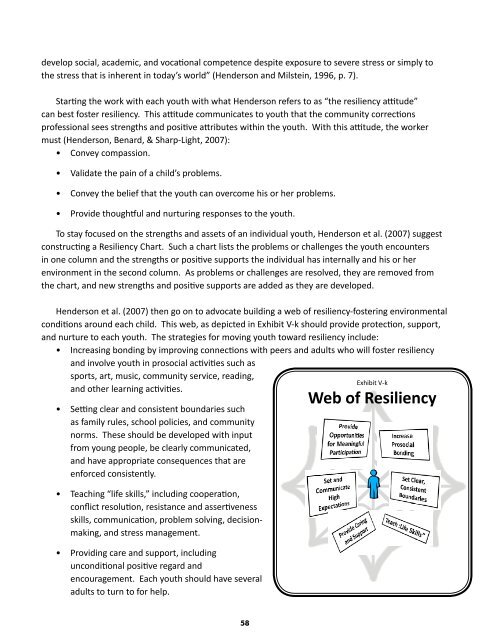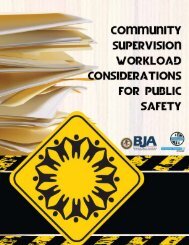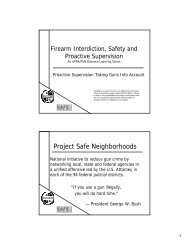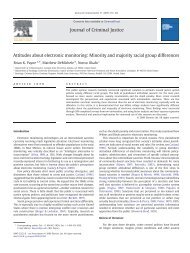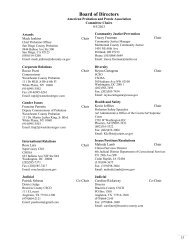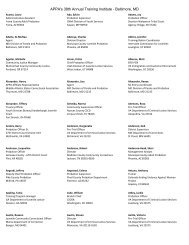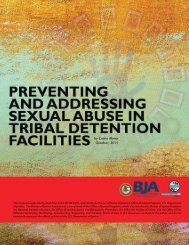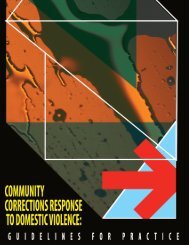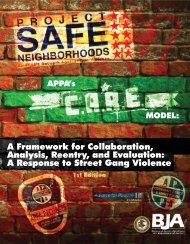Intervention Principles and Practice Guidelines for - Underage ...
Intervention Principles and Practice Guidelines for - Underage ...
Intervention Principles and Practice Guidelines for - Underage ...
Create successful ePaper yourself
Turn your PDF publications into a flip-book with our unique Google optimized e-Paper software.
develop social, academic, <strong>and</strong> vocational competence despite exposure to severe stress or simply to<br />
the stress that is inherent in today’s world” (Henderson <strong>and</strong> Milstein, 1996, p. 7).<br />
Starting the work with each youth with what Henderson refers to as “the resiliency attitude”<br />
can best foster resiliency. This attitude communicates to youth that the community corrections<br />
professional sees strengths <strong>and</strong> positive attributes within the youth. With this attitude, the worker<br />
must (Henderson, Benard, & Sharp-Light, 2007):<br />
• Convey compassion.<br />
• Validate the pain of a child’s problems.<br />
• Convey the belief that the youth can overcome his or her problems.<br />
• Provide thoughtful <strong>and</strong> nurturing responses to the youth.<br />
To stay focused on the strengths <strong>and</strong> assets of an individual youth, Henderson et al. (2007) suggest<br />
constructing a Resiliency Chart. Such a chart lists the problems or challenges the youth encounters<br />
in one column <strong>and</strong> the strengths or positive supports the individual has internally <strong>and</strong> his or her<br />
environment in the second column. As problems or challenges are resolved, they are removed from<br />
the chart, <strong>and</strong> new strengths <strong>and</strong> positive supports are added as they are developed.<br />
Henderson et al. (2007) then go on to advocate building a web of resiliency-fostering environmental<br />
conditions around each child. This web, as depicted in Exhibit V-k should provide protection, support,<br />
<strong>and</strong> nurture to each youth. The strategies <strong>for</strong> moving youth toward resiliency include:<br />
• Increasing bonding by improving connections with peers <strong>and</strong> adults who will foster resiliency<br />
<strong>and</strong> involve youth in prosocial activities such as<br />
sports, art, music, community service, reading,<br />
<strong>and</strong> other learning activities.<br />
• Setting clear <strong>and</strong> consistent boundaries such<br />
as family rules, school policies, <strong>and</strong> community<br />
norms. These should be developed with input<br />
from young people, be clearly communicated,<br />
<strong>and</strong> have appropriate consequences that are<br />
en<strong>for</strong>ced consistently.<br />
• Teaching “life skills,” including cooperation,<br />
conflict resolution, resistance <strong>and</strong> assertiveness<br />
skills, communication, problem solving, decisionmaking,<br />
<strong>and</strong> stress management.<br />
• Providing care <strong>and</strong> support, including<br />
unconditional positive regard <strong>and</strong><br />
encouragement. Each youth should have several<br />
adults to turn to <strong>for</strong> help.<br />
Exhibit V-k<br />
Web of Resiliency<br />
58


